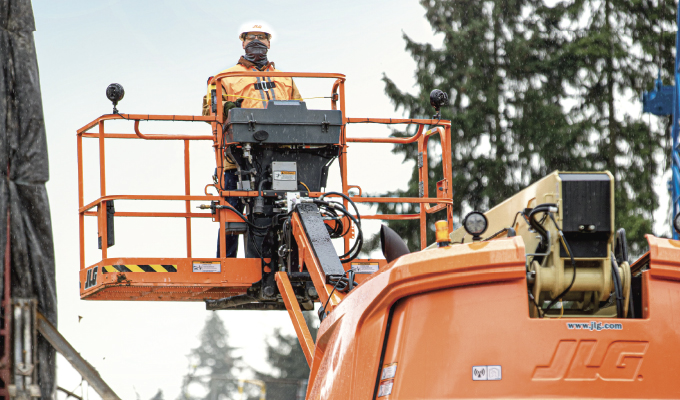From the first time Skanska heard about JLG’s new self-leveling boom lift, they were all in.
Tragedies in the industry had led Skanska to believe there must be a better way to work at height on uneven ground. Here was their answer.
The JLG® 670SJ boom lift uses a fully integrated, smart adapting steel chassis with self-leveling technology to automatically adapt to terrain on slopes up to 10 degrees in any direction. This means the 670SJ can more easily navigate rough jobsite terrain while the platform is elevated with full machine functionality, and it reduces the need for cribbing or pre-grading the pad in order for it to get to work.
Contractors like Skanska, say technology like this lowers the risks of tip-overs, makes operators more comfortable while traveling at height, improves access with its ability to get closer to the work area, and saves production time spent leveling the site before work can begin.
A BETTER, SAFER POSITION
It was 2017 when Mason Ford, director of sustainability and equipment services for Skanska, met with the JLG team about the self-leveling chassis, at that time only a concept.
“We have been a supporter of it since the moment we heard they were building it,” Ford says.
Once ready for the field, Skanska put the 670SJ to work on the Lynnwood Link L300 project in Mountlake Terrace, Washington, a nearly 4-mile raised extension of the Sound Transit rail line outside of Seattle. Skanska USA, headquartered in New York City, New York, is the sole contractor for the project.
Ford says it was the perfect test case for the self-leveling boom lift, because of the site’s unprepared surfaces located where they needed to access girders for the line. Normally for that type of work, Skanska would use a 60-foot boom lift only after a significant amount of grading, which can take 2 to 3 hours.
This means extra machines are basically doing unproductive work, since the pad would need to be graded out once the boom lift’s portion is completed.
“It would also involve cribbing and blocking,” Ford says. “Even more so, it would mean slower project transitions and production, because to do a lot of the work, the operator would have to boom down, move the lift on an uneven surface to get to the next prepared work surface, and then raise back up and stretch back out to do the work.”
On top of this, the creation of the pad in congested areas may prevent other equipment from accessing the site.
“It’s more than time and direct cost—it’s whether you even have the opportunity to make that footprint available,” he says. “There are even cases where instead of using the 60-foot boom lift, we’d have to go to an 80-foot because we need more reach to access the area.”
But none of these challenges are concerns for the 670SJ. With four independent control arms instead of a solid oscillating axle in the front and a fixed axle in the rear like with traditional boom lifts, each wheel is attached to an arm that separately adjusts as sensing technology recognizes uneven ground.
Another benefit is that it provides operators with a smoother, safer ride as they travel on the site. In a traditional boom lift, it doesn’t take much for operators or objects to bounce around when you’re at height—even pebbles on the ground can have an impact when elevated.
“The self-leveling chassis absorbs changes in the surface that you’re working on,” Ford says. “It provides a safe experience for that person who’s in the platform.”
Skanska has also used the 670SJs on the Hunts Point Peninsula interchange project in New York City and on the State Route 60 road widening project in hilly Southern California.
After initially putting several models to work, Skanska now owns them, and Ford says they’ve become an essential part of their fleet.
“For us heavy civil contractors that work in dynamic conditions with varying slopes and varying terrains, the 670SJ is important,” Ford says.
SAVING TIME, MONEY
All that the crews requested for a Maine substation project was a 60-foot straight boom lift.
When they tried the 670SJ, it exceeded their expectations, says Jeremy Moody, assistant project superintendent for Cianbro.
The contractor, headquartered in Pittsfield, Maine, used the 670SJ to install switches and above-grade electrical components as part of the Bowman Street substation expansion in Farmingdale. Cianbro handled the earthwork, concrete foundations, steel erection, and electrical work for the project.
It was the time- and cost-saving capabilities of the 670SJ that made the most impact, says Chad Burgess, dispatch supervisor for Cianbro.
“The amount of time this self-leveling feature saves is a huge asset to any fleet,” Burgess says. “Typically, if we need a lift on the back of an elevated site, we would need to have earthmoving equipment, such as—but not limited to—excavators, dump trucks, skid steers, or even rollers.”
He found that in most cases, the 670SJ curbs the renting or reassigning of additional equipment on the site for grading.
“This saves on permits, hiring trucks, the number of operators with special licenses, and countless other cost savings,” Burgess says.
As a result, it can radically change equipment planning and selection, as well as project timelines, he says.
“They liked that when traveling, the platform wasn’t moving around,” Moody says.
CLOSING THOUGHT
“Companies performing work in cities where one side of the machine needs to be on a sidewalk would also benefit from a self-leveling unit,” finishes Burgess. “The cost savings to the job are endless.”
About the Author:
Sara Vincent is the director of marketing with JLG. For more, visit jlg.com.
Modern Contractor Solutions, May 2023
Did you enjoy this article?
Subscribe to the FREE Digital Edition of Modern Contractor Solutions magazine.



